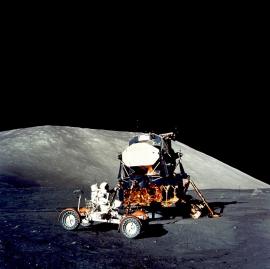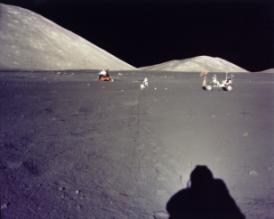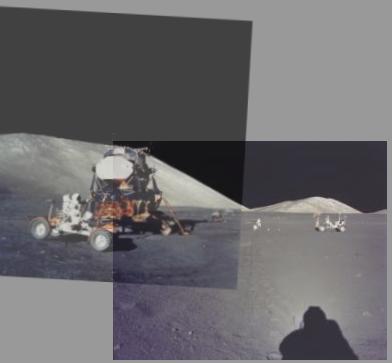big mountains







|
|
|
As shown in Fig. 2, the fiducial grid demonstrates that the photo on the right has been enlarged to more than twice the scale of the photo on the left. We can directly observe that the western end of the South Massif summit is approximately one fiducial tall in both photos.
|
Fig. 3 shows the two photos White used to compose his comparison. They are shown here uncropped, except for minor cropping inherent to the scanning. The reseau fiducials were used to normalize the scale of the images. That is, the distance between fiducials is the same in each photo. This guarantees that we are seeing the relative sizes of the images as they appeared on the original camera transparencies.
|
In Fig. 3 the eye can still detect a difference in appearance between what are supposed to be identical summit lines. This is because the camera is tilted slightly differently in each photo. In Fig. 4 the scale of the images is preserved as in Fig. 3, but the photos have been registered to show the alignment of the foothill horizon and the ridgeline and summit line.
It is common to assume that lunar mountains are nearby because their rounded shape resembles hills on earth, and because the lack of atmosphere denies the depth cueing that is provided by atmospheric attenuation on earth ("haze"). Nevertheless the South Massif is kilometers away from the landing site. Although the photographs are taken from positions more than a hundred meters apart, that makes a negligible difference in the appearance of mountains that are kilometers away and on the order of a thousand meters high.
Thus we correctly expect to see a vast difference in the apparent size of the lunar module, but little or no difference in the apparent size of distant mountains. These photos do not present an anomalous scenario. The apparent discrepancy was a product of Jack White's composition and editing, not of an inherent inconsistency in the objects being photographed or their appearance in the full frame.

 Fig. 1 (left) shows a
small mountain and a big LM. Fig. 1 (right) shows a large mountain
and a small LM. If the LM is smaller on the right because the
photographer is farther away, how can a genuine mountain behind it
appear larger, since it too must be farther away? [Jack
White]
Fig. 1 (left) shows a
small mountain and a big LM. Fig. 1 (right) shows a large mountain
and a small LM. If the LM is smaller on the right because the
photographer is farther away, how can a genuine mountain behind it
appear larger, since it too must be farther away? [Jack
White]




